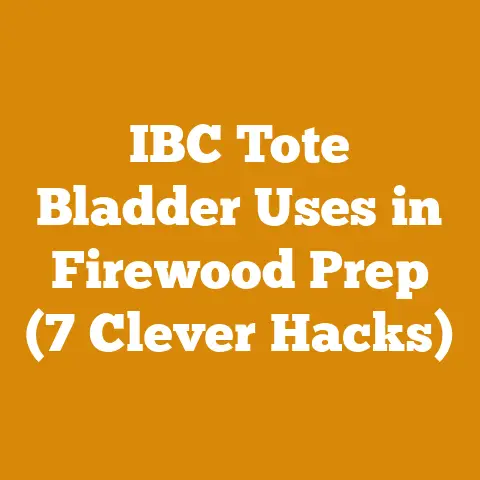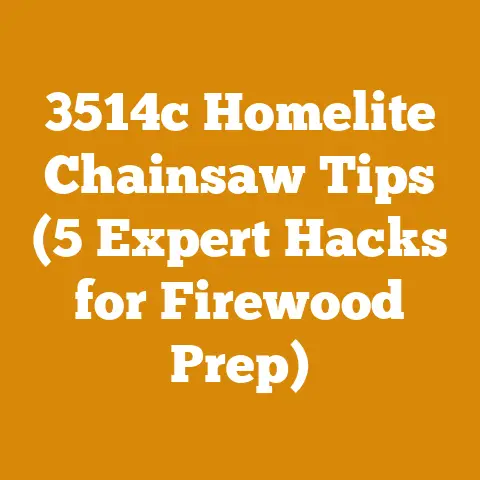Chimney Creosote Removal (5 Pro Tips for Safe Wood Burning)
Let’s bust a myth right away: many people believe that burning only seasoned wood completely eliminates creosote buildup in your chimney. While seasoned wood significantly reduces creosote formation, it doesn’t eliminate it entirely. Creosote is a byproduct of incomplete combustion, and even the best-seasoned wood can produce some. Ignoring this fact is a recipe for a chimney fire, and I’ve seen the aftermath firsthand.
Chimney creosote removal is a critical aspect of safe wood burning, whether you’re a seasoned logger, a homeowner relying on wood for heat, or someone who simply enjoys a cozy fire on a cold evening. Over the years, I’ve learned that understanding creosote formation, implementing proactive burning practices, and knowing how to safely remove creosote are essential for preventing dangerous chimney fires and ensuring the longevity of your wood-burning appliance. In this guide, I’ll share five pro tips based on my experiences and knowledge in wood processing and firewood preparation.
Understanding Creosote: The Silent Threat
Creosote is a black or brown residue that accumulates inside your chimney or flue. It’s formed when smoke, unburned wood particles, and other byproducts of combustion condense on the cooler surfaces of the chimney. Think of it like the buildup inside a greasy frying pan, only far more flammable.
There are three stages of creosote:
- Stage 1 (Soot): This is a light, flaky deposit that’s relatively easy to remove. It’s primarily composed of soot and ash.
- Stage 2 (Flaky or Granular): This creosote is more hardened and tar-like. It’s more difficult to remove than Stage 1 creosote.
- Stage 3 (Glazed or Shiny): This is the most dangerous form of creosote. It’s a hard, shiny, tar-like glaze that’s extremely flammable and difficult to remove, often requiring professional intervention.
The danger lies in the fact that creosote is combustible. A hot enough ember or stray spark can ignite the creosote, leading to a chimney fire. These fires can be incredibly destructive, spreading to the rest of your home and causing significant damage or even loss of life. I remember one incident where a neighbor, convinced he had no creosote problem, suffered a devastating chimney fire that nearly destroyed his house. The investigation revealed a thick layer of Stage 3 creosote hidden within his chimney.
Key Terms and Concepts
Before diving into creosote removal, let’s define some essential terms:
- Seasoned Wood: Wood that has been properly dried to a moisture content of 20% or less. This is crucial for efficient burning and minimizing creosote formation.
- Green Wood: Freshly cut wood with a high moisture content (often above 50%). Burning green wood produces excessive smoke and creosote.
- Firebox: The area within your wood stove or fireplace where the fire burns.
- Flue: The passageway inside your chimney that carries smoke and combustion gases to the outside.
- Damper: A movable plate within the flue that regulates airflow.
- Chimney Cap: A covering placed on top of the chimney to prevent rain, snow, and debris from entering.
- Draft: The flow of air through the chimney, which is essential for proper combustion.
Pro Tip 1: Burn Seasoned Wood – The Foundation of Creosote Control
This might seem obvious, but it’s the single most important factor in preventing creosote buildup. Green wood contains a significant amount of water, which must be evaporated during combustion. This process lowers the temperature in the firebox and flue, leading to incomplete combustion and increased creosote formation.
My Experience: I once tried to burn some oak that I thought was seasoned, but it turned out to be only partially dry. The amount of smoke it produced was unbelievable, and I could practically see the creosote forming in my chimney. I learned my lesson: always double-check the moisture content of your wood.
How to Season Wood Properly:
- Choose the Right Wood: Hardwoods like oak, maple, and ash are generally better for burning than softwoods like pine and fir. While softwoods can be used, they tend to burn faster and produce more creosote.
- Cut and Split: Split the wood into manageable pieces. This increases the surface area exposed to air, speeding up the drying process. Aim for pieces that are approximately 4-6 inches in diameter.
- Stack Properly: Stack the wood off the ground on pallets or supports to allow for air circulation. Leave space between rows to further enhance airflow. A single row, exposed to the wind and sun, will dry faster than a tightly packed stack.
- Location, Location, Location: Stack the wood in a sunny and windy location. This will help to evaporate the moisture more quickly. Avoid stacking wood in damp or shaded areas.
- Cover Strategically: Covering the top of the woodpile with a tarp or roof will protect it from rain and snow, but leave the sides open for ventilation.
- Moisture Meter is Your Friend: Invest in a wood moisture meter. This inexpensive tool will allow you to accurately measure the moisture content of your wood. Aim for a moisture content of 20% or less.
- Time is Key: Seasoning wood takes time. The exact duration depends on the type of wood, the climate, and the stacking method. Generally, hardwoods require at least 6-12 months of seasoning. Softwoods may season more quickly.
Data and Insights: Studies have shown that burning seasoned wood can reduce creosote formation by as much as 50-80% compared to burning green wood. This translates to a significantly lower risk of chimney fires and improved heating efficiency.
Tools and Specifications:
- Chainsaw: A chainsaw is essential for cutting logs into manageable lengths. I prefer using a Stihl MS 261 for its power and reliability. Ensure the chain is sharp and properly tensioned for efficient cutting.
- Axe or Log Splitter: An axe or log splitter is needed for splitting the wood. For smaller quantities, a splitting axe works well. For larger quantities, a hydraulic log splitter can save a significant amount of time and effort. I use a 27-ton hydraulic splitter, which can handle even the toughest hardwood.
- Wood Moisture Meter: A wood moisture meter is crucial for determining when the wood is properly seasoned. I recommend a pin-type meter for accurate readings.
- Pallets or Supports: Pallets or supports are needed to elevate the wood off the ground.
- Tarp or Roofing Material: A tarp or roofing material is needed to protect the wood from rain and snow.
Case Study: I helped a friend who was struggling with excessive creosote buildup in his chimney. He was burning wood that he had cut only a few months prior. We spent a weekend cutting, splitting, and stacking his wood properly, and I loaned him my moisture meter. The following year, he burned only seasoned wood, and his creosote problem was virtually eliminated.
Pro Tip 2: Burn Hot, Clean Fires – Maximize Combustion Efficiency
The way you burn your wood is just as important as the type of wood you burn. Burning hot, clean fires promotes complete combustion, which minimizes creosote formation.
My Experience: I used to believe that smoldering fires were more efficient because they burned longer. However, I quickly learned that they produce far more smoke and creosote. Now, I prioritize burning hot, clean fires, even if it means adding wood more frequently.
How to Burn Hot, Clean Fires:
- Airflow is King: Ensure adequate airflow to the fire. Open the damper fully when starting the fire and adjust it as needed to maintain a hot, clean burn. Avoid closing the damper too much, as this will restrict airflow and promote creosote formation.
- Top-Down Burning: Consider using a top-down burning method. This involves placing larger pieces of wood at the bottom of the firebox and smaller pieces on top. This allows the fire to burn downwards, which promotes more complete combustion and reduces smoke.
- Avoid Overloading: Don’t overload the firebox with too much wood. This can smother the fire and prevent proper airflow. Add wood gradually as needed to maintain a hot, clean burn.
- Regularly Remove Ashes: Regularly remove ashes from the firebox. Excessive ash buildup can restrict airflow and reduce the efficiency of the fire.
- Burn Seasoned Wood (Again!): I can’t stress this enough. Burning seasoned wood is essential for achieving a hot, clean burn.
Data and Insights: Studies have shown that burning hot, clean fires can reduce creosote formation by as much as 30-50% compared to burning smoldering fires. This also improves the efficiency of your wood-burning appliance, resulting in lower fuel consumption and reduced emissions.
Strategic Advantages: Burning hot, clean fires not only reduces creosote buildup but also improves the overall efficiency of your wood-burning appliance. This can save you money on fuel and reduce your environmental impact.
Pro Tip 3: Regular Chimney Inspections – Catch Problems Early
Regular chimney inspections are crucial for identifying potential problems, including creosote buildup, before they become dangerous.
My Experience: I make it a point to inspect my chimney at least twice a year, once before the heating season and once after. During one inspection, I noticed a small crack in the flue liner. I was able to repair it before it became a major problem, potentially saving me from a costly chimney fire.
How to Inspect Your Chimney:
- Visual Inspection: Visually inspect the exterior of your chimney for cracks, damage, or deterioration. Pay close attention to the chimney cap, flashing, and brickwork.
- Interior Inspection: Use a flashlight to inspect the interior of the flue. Look for signs of creosote buildup, cracks, or other damage.
- Professional Inspection: Hire a qualified chimney sweep to perform a professional inspection at least once a year. They have the tools and expertise to identify potential problems that you might miss.
Data and Insights: The National Fire Protection Association (NFPA) recommends that chimneys be inspected at least once a year. Regular inspections can help to identify and address potential problems before they lead to chimney fires.
Costs and Skill Levels: A visual inspection can be performed by the homeowner and requires no special skills. A professional chimney inspection typically costs between \$100 and \$300, depending on the location and complexity of the inspection.
Pro Tip 4: Safe Creosote Removal – Know Your Limits
If you find creosote buildup during your chimney inspection, it’s essential to remove it safely. However, it’s important to know your limits and when to call a professional.
My Experience: I’ve cleaned my own chimney for years, but I always take safety precautions and use the right tools. I once attempted to remove a particularly stubborn patch of Stage 3 creosote, but it was too hard and I was worried about damaging the flue liner. I decided to call a professional, who was able to remove it safely and efficiently.
How to Remove Creosote Safely:
- Safety First: Wear safety glasses, a dust mask, and gloves to protect yourself from creosote dust and debris.
- Choose the Right Tools: Use a chimney brush that is the correct size and shape for your flue. You can purchase chimney brushes at most hardware stores. Avoid using metal brushes on metal flues, as this can damage the flue liner.
- Start from the Top: Start cleaning the chimney from the top down. This will allow the creosote to fall into the firebox, making it easier to remove.
- Use a Chimney Sweep Rod: Attach the chimney brush to a chimney sweep rod. These rods are designed to be flexible and durable, allowing you to reach the entire length of the flue.
- Scrub Thoroughly: Scrub the flue thoroughly to remove as much creosote as possible. Pay close attention to areas where creosote buildup is particularly heavy.
- Remove Debris: Remove the creosote and debris from the firebox. Dispose of the debris properly.
- Professional Help: If you are uncomfortable cleaning your own chimney, or if you find a significant amount of Stage 3 creosote, call a qualified chimney sweep.
Tools and Specifications:
- Chimney Brush: Choose a chimney brush that is the correct size and shape for your flue. The diameter of the brush should be slightly larger than the diameter of the flue.
- Chimney Sweep Rod: Use a chimney sweep rod that is long enough to reach the entire length of the flue.
- Safety Glasses: Wear safety glasses to protect your eyes from creosote dust and debris.
- Dust Mask: Wear a dust mask to protect your lungs from creosote dust and debris.
- Gloves: Wear gloves to protect your hands from creosote dust and debris.
Case Study: I once helped a neighbor clean his chimney. He had been burning green wood for several years, and his chimney was heavily coated with creosote. We spent an entire day scrubbing the flue, but we were able to remove most of the creosote. He learned his lesson and started burning seasoned wood, and he hasn’t had a creosote problem since.
Pro Tip 5: Chemical Creosote Removers – Use with Caution
Chemical creosote removers can help to loosen creosote buildup, making it easier to remove. However, they should be used with caution and according to the manufacturer’s instructions.
My Experience: I’ve used chemical creosote removers in the past, but I always follow the instructions carefully and wear appropriate safety gear. I find that they can be helpful for loosening Stage 1 and Stage 2 creosote, but they are not a substitute for regular chimney inspections and cleaning.
How to Use Chemical Creosote Removers:
- Read the Instructions: Carefully read and follow the manufacturer’s instructions.
- Safety First: Wear safety glasses, a dust mask, and gloves to protect yourself from the chemicals.
- Apply Properly: Apply the chemical creosote remover according to the instructions. This may involve spraying it into the firebox or chimney, or burning a treated log.
- Wait: Allow the chemical creosote remover to work for the recommended amount of time.
- Clean the Chimney: After the recommended time has elapsed, clean the chimney as described in Pro Tip 4.
- Ventilation: Ensure proper ventilation when using chemical creosote removers.
Strategic Insights: Chemical creosote removers can be a useful tool for loosening creosote buildup, but they are not a substitute for regular chimney inspections and cleaning. They should be used with caution and according to the manufacturer’s instructions.
Practical Next Steps and Implementation Guidance
Now that you’ve learned about creosote and how to prevent and remove it, here are some practical next steps you can take:
- Assess Your Wood Supply: Evaluate your current wood supply. Is it properly seasoned? If not, start seasoning wood now for next year’s heating season.
- Inspect Your Chimney: Perform a visual inspection of your chimney. Look for any signs of damage or creosote buildup.
- Schedule a Professional Inspection: If you are unsure about the condition of your chimney, schedule a professional inspection with a qualified chimney sweep.
- Clean Your Chimney: If you find creosote buildup, clean your chimney using the methods described in this guide. If you are uncomfortable cleaning your own chimney, call a qualified chimney sweep.
- Adjust Your Burning Practices: Implement the burning practices described in this guide, such as burning hot, clean fires and avoiding overloading the firebox.
- Consider a Chemical Creosote Remover: If you want to try a chemical creosote remover, choose a reputable product and follow the manufacturer’s instructions carefully.
- Regular Maintenance: Make regular chimney inspections and cleaning a part of your routine. This will help to prevent chimney fires and ensure the longevity of your wood-burning appliance.
By following these pro tips, you can significantly reduce the risk of chimney fires and enjoy the warmth and comfort of a wood-burning fire safely and efficiently. Take the time to learn about creosote and how to prevent and remove it, and you’ll be able to enjoy your wood-burning appliance for many years to come.






